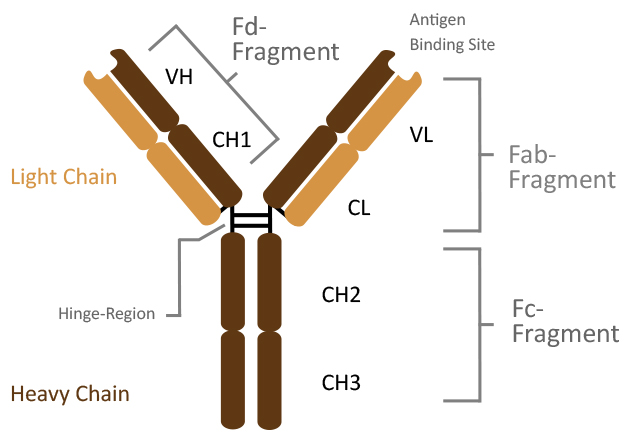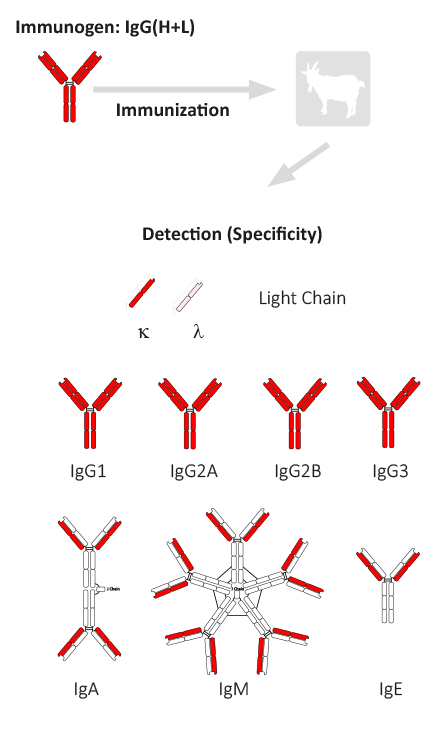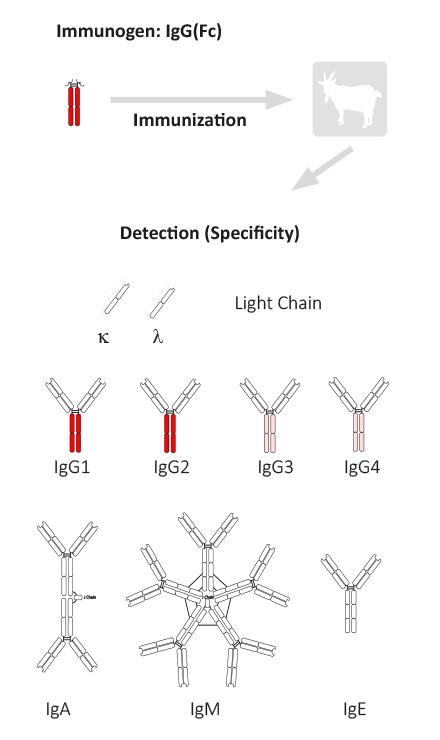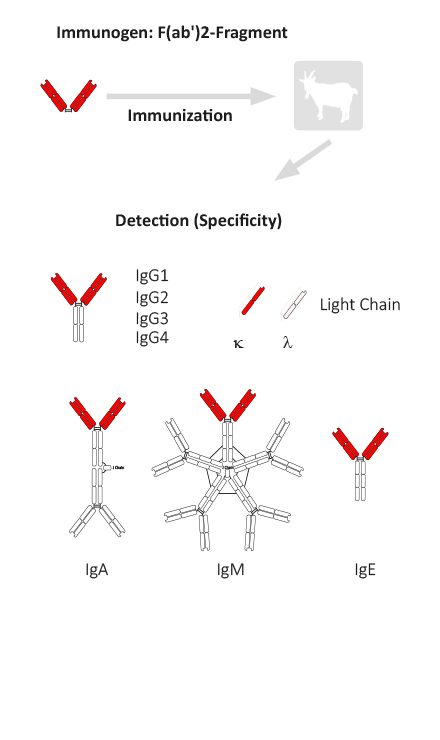What should a secondary antibody detect? Examples of immunization and the resulting specificity (detection)
For immunological assays, polyclonal antibodies of the IgG type (e.g. from rabbit, goat, chicken, etc.) or monoclonal antibodies from mouse, rat or hamster, derived from B-cell hybridomas, are used. Secondary antibodies should have a high sensitivity for this primary antibody.
Generally, this is a secondary antibody for which a total molecule IgG(H+L) was used as the immunogen. In this case the resulting antibodies recognize a variety of epitopes on antibodies of different classes and subclasses. (see figure antibody structure). In the examples below, this cross-reactivity is explained using 3 examples and the resulting specificities.
If only one primary antibody is to be detected in an experiment and immunoglobulins of other classes or subclasses are not a confounding factor, as is the case in most applications, specificity IgG (H+L) is usually most appropriate.
Frequently, several primary antibodies from different species are to be detected simultaneously in one experiment (multiple labeling). In this case, cross-reaction must be prevented. This is done by adsorption of antibodies to immunoglobulins from other species. In this case the optimal specificity for each of the secondary antibodies is still IgG(H+L).
IgG as reference structure for immunoglobulins
An immunoglobulin G (IgG) consists of two identical light (“L “ight) and heavy (“H “eavy) polypeptide chains connected by covalent disulfide bridges. The lower region is called the Fc fragment (fragment crystallizable). The two arms, each formed by the upper part of the H-chain and an L-chain, are called Fab fragment (antigen binding fragment). The light chains each consist of a variable domain (VL) and a constant domain (CL). The heavy chains, on the other hand, each have one variable and three constant domains. These are designated analogously as VH and CH1, CH2, CH3.

Example of the preparation of an antibody of specificity IgG (H+L) of the mouse.

The animal host species (e.g. goat) is immunized with purified mouse immunoglobulin IgG(H+L). As a rule, the immunoglobulins used for immunization are obtained from total serum, i.e. the composition of the individual subclasses and components corresponds to the normal distribution in the serum of the species.
Antiserum of goat immunized with IgG(H+L) contains antibodies directed against both the light and heavy chains of the IgG molecule. This antiserum reacts with both the F(ab’)2-Fragment and the Fc-Fragment of IgG. Anti-IgG therefore also reacts very well with other immunoglobulin classes (IgM, IgA, IgE), since they have the same light chains (κ and λ). The anti-IgG (H+L) antibodies that are not preadsorbed have about 40% – 60% reactivity with light chains. For highly adsorbed anti-IgG (H+L) antibodies this ratio can be much lower.
Example of the preparation of an anti-human antibody with the specificity IgG (Fc).

Immunization (e.g. of goat) with purified IgG Fc fragment (e.g. from human) leads to antibodies that are specific for the heavy chain of the IgG molecule. Since the differences between the various immunoglobulin classes are located on the heavy chain region, IgG, but not IgM, IgA and IgE, are detected. These Fc fragment-specific antibodies are often preadsorbed against F(ab’)2 fragments. In some cases, a possible cross-reaction against IgM and IgA (anti-human) or only against IgM (anti-mouse, anti-rat) is also minimized by further preadsorption(s). These antibodies (anti-human, anti-mouse, anti-rat) are identified by “Fcγ”. They have less than 1% residual activity against light chains or IgM or IgA.
Anti-IgG (Fc) antibodies do not react with all IgG subclasses equally well as anti-IgG, F(ab’)2 fragment-specific antibodies. Due to the low percentage of antibodies against the rare IgG subclasses (IgG3 and IgG4), it is better to use anti-IgG (H+L) or anti-IgG F(ab’)2 antisera to detect these subclasses.
Example of the preparation of an anti-human antibody with the specificity IgG F(ab‘)2.

These antibodies are obtained by immunization with purified F(ab’)2 fragment of total IgG. The heavy chain of the F(ab’)2 fragment is only weakly immunogenic. Antibodies obtained in this way are directed to more than 60% against the light chain dependent on the degree of preadsorption. Anti-F(ab’)2 fragment antibodies are frequently preadsorbed against IgG Fc fragment and react only with the Fab portion of IgG.
With these immunoreagents, all lg classes and subclasses (IgM, IgG1-4, IgA, etc.) can be detected to a similar degree. These antibodies are ideally suited if all Ig classes are to be detected regardless of subclass or if it is not certain which class the primary antibody belongs to.
Since the respective antiserum (e.g., from goat) is predominantly directed against κ-type light chains, the sensitivity of anti-F(ab’)2 fragment antibodies in detecting primary antibodies carrying λ-type light chains is limited

dianova.com is the portal for secondary antibodies and conjugates from BIOZOL. In our secondary antibodies search you will find more than 7000 secondary antibodies. This online guide will help you to find the right secondary antibody for your application.
In our antibody search, you can select the properties you need by choosing from 6 properties in drop-down menus, allowing you to quickly and easily find the products best suited to your needs.
You have additional questions? Our scientific consulting team will be happy to help you.
We are happy to advise you at any time.
